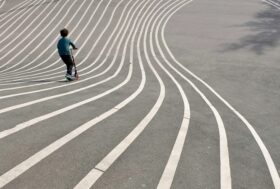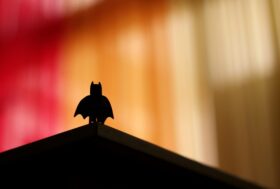Adolescent sleep and educational performance

On a societal level we often see sleep as an afterthought, taking time away from our other pursuits. To an adult, this may be staying late in the office. For an adolescent, this may be staying up late to socialise with friends through electronic media. However, this comes at a cost. We know that sleep is fundamental for learning, memory consolidation and information processing, alongside restoration and repair of the body. Adolescents are particularly vulnerable to sleep disruption around puberty, as both physical and behavioural changes impact upon sleep, which, in turn, can influence their ability to engage in the classroom and learn.
The biology of sleep
Sleep and circadian rhythms are not the same. Circadian rhythms describe internally generated 24-hour oscillations in physiology and behaviour that enable an individual to anticipate and adapt to the changing daily demands of the environment, most notably the profound daily changes in light, temperature and the availability of food. Circadian rhythms are generated within cells through the activation and suppression of clock genes over a period of close to 24 hours. An area of the brain called the suprachiasmatic nuclei (SCN) acts as a ‘master biological clock’, which then coordinates the circadian rhythms of billions of clock cells in tissues and organs throughout the rest of the body. As a result, there is a network of clocks, and this is referred to as the ‘circadian system’. Small changes in these genes have been linked to an individual’s ‘chronotype’, which is our preferred sleep/wake timing – for example, the time of the day when we feel most alert or sleepy. A clock that runs faster will make individuals go to bed and get up early (‘larks’), whereas a slower clock will drive the sleep/wake cycle to a later time (‘owls’).
Left to its own devices, the circadian system is not exactly 24 hours and so needs a daily adjustment to ‘force’ internal time to align with external 24 hour day (Baum et al., 2014). The SCN is adjusted, or entrained, primarily by the changes in light intensity at dawn and dusk. This light/dark signal is detected by the specialised photoreceptors within the eye that are most sensitive to blue light (Foster and Kreitzman, 2017). The clocks throughout the rest of the body (for example, in the gut, liver, muscles, etc.) are usually entrained by the SCN, but can be adjusted separately by a number of other factors, such as when we eat, social activity and temperature (Foster and Kreitzman, 2017). It is also important to note that light plays another role in sleep regulation. The same specialised photoreceptors in the eye that regulate the circadian system are also used to change levels of alertness. Bright light increases alertness, and so if individuals are exposed to relatively bright light before bedtime, this will increase alertness and delay the onset of sleep (Foster and Kreitzman, 2017).
The timing of sleep is driven not only by the circadian system but also by a homeostatic process, whereby an increased duration of wakefulness leads to an increased need for sleep. This homeostatic drive for sleep seems to be due to a number of neurochemicals that build up in the brain. The best understood is adenosine, which increases during the waking day. We would feel really sleepy mid-afternoon if it were not for an opposing circadian drive for wakefulness. When the circadian system judges that it is ‘appropriate’ for sleep, the drive for wakefulness is terminated, the homeostatic drive for sleep kicks in and sleep occurs. We sleep best when our drive for sleep is appropriately aligned to our circadian rhythm for wake. Jet lag is the classic example of a mismatch between these two drivers (Foster and Kreitzman, 2017).
Adolescent sleep changes
Sleep timing (chronotype) is determined by multiple factors, and changes in the human chronotype are most marked during adolescence, where sleep onset becomes markedly delayed (Foster and Kreitzman, 2017); (Roenneberg et al., 2004). This delay is partly driven by psychosocial factors, such as peer and media influence, increased social opportunities, assertion of autonomy, and withdrawal of parental control, and biological processes involving developmental changes in the circadian timing system, and altered sensitivities to dawn/dusk light stimuli. Due to these changes, children show an increasing preference to go to bed later (becoming ‘owls’), which peaks at around 19 years for females and 21 years for males, after which there is a slow move towards becoming a ‘lark’. On average, there is about a two-hour difference (delay) in chronotype between adolescents in their late teens and individuals in their late fifties (Roenneberg et al., 2004).
This delay in biological chronotype, coupled with alarm clock use on school days to wake in time for lessons, results in a progressive shortening of total sleep time. The preference to go to bed and wake later on free days compared to school days contributes to a state of ‘social jet lag’ – the disparity between sleeping in accordance with chronotype (weekends) and sleeping in accordance with school demands. Significantly, higher levels of social jet lag are correlated with poorer levels of academic performance in undergraduates (Haraszti et al., 2014).
Finally, the timing of light must be taken into consideration. Light at dusk delays the clock, so that individuals get up later the next day, whilst morning light advances the clock (individuals get up earlier the next day) (Foster and Kreitzman, 2017). This is important because if adolescents see more evening light, but miss light in the morning (for example, oversleeping at the weekend), their clocks will be delayed. It has been proposed that changes in the adolescent eye mean that light in the evening, such as that emitted by electronic devices, may have a far greater delaying effect on the clock than in adults. Indeed, there is some evidence that early pubertal adolescents experience increased sensitivity to entraining light stimuli (Crowley et al., 2015).
The impact of sleep deprivation and sleepiness in the classroom
The National Sleep Foundation in 2015 recommended that 14–17-year-old adolescents should have eight to 10 hours of sleep each night. Studies estimate that students lose, on average, 120 minutes of sleep a night on school nights comparative to the holidays (Hansen et al., 2005), and pilot data from the University of Oxford’s Teensleep project (unpublished) have indicated that UK adolescents are achieving around seven hours’ sleep on a school night yet wish to have around nine hours.
It is well established that insufficient sleep is associated with reduced attention, impaired learning and poorer academic performance (Curcio et al., 2006). For example, in a study of 39 children (six to 12 years), when sleep was experimentally shortened (eight hours for younger students, six and a half hours for older students), teachers rated the academic performance and attention of the students significantly worse than prior to the sleep restriction (Fallone et al., 2005). Lo and colleagues (Lo et al., 2016) restricted sleep to five hours or extended sleep to nine hours for seven nights, and evaluated cognitive performance. When compared to students in the extended sleep group, the students given sleep restriction showed significant deficits, including in executive function, working memory (our ability to temporarily store and manipulate information) and sustained attention. Following sleep restriction, the students in this group had three recovery nights, each with an opportunity for nine hours’ sleep. The authors reported that, despite sleep extension, those that had been sleep restricted still showed deficits in their ability to sustain attention and remain alert, illustrating that recovering from restricted sleep takes more than can be achieved in a weekend.
A large questionnaire-based survey conducted in Sweden between 2005 and 2011, involving approximately 40,000 adolescents (12–19 years), included questions on subjective sleep disturbances and sleep duration. Titova and colleagues (Titova et al., 2015) then identified those students who had reported poor sleep (difficulties falling asleep, restless sleep and nightmares) in the previous three months. They found that these students were more likely to fail a subject at school than those who did not report poor sleep.
In addition to links with cognitive and academic outcomes, poor sleep has been shown to be associated with mood and emotional deficits. For example, Baum et al. (Baum et al., 2014) asked students to complete questionnaires on mood and mood regulation, and compared their responses when they were experiencing sleep restriction (6.5 hours in bed per night for five nights) with a period of optimal sleep (10 hours in bed per night for five nights). Adolescents rated themselves as more tense/anxious and angry/hostile during sleep restriction compared with a longer sleep duration. Parents and adolescents also reported poorer emotional regulation and greater oppositionality/irritability during sleep restriction compared with the longer sleep duration. Notably, these findings showed that after only a few days of shortened sleep, at a level routinely experienced by many adolescents, students had worsened mood and were less able to regulate negative emotions.
Sleep extensions: A case for delaying school start times
Because of the delay in sleep/wake timing, asking a teenager to wake for school at 07:00 is the equivalent of asking an adult to wake at around 05:00! Consequently, schools have taken part in interventions to address the timing of the school day. Wheaton and colleagues (Wheaton et al., 2016) evaluated 38 studies involving a delay in school start times and summarised that later school start times were associated with an improvement in attendance, a reduction in sleepiness in class and improved academic performance. Similarly, another analysis evaluated six studies where school times were changed. School start times were delayed between 25 and 60 minutes. Significantly, students had a corresponding increase in total sleep time each school night of 25 to 77 minutes (Minges and Redeker, 2016). An independent high school in the US delayed the start of lessons from 08:00 to 08:25 (Boegers et al., 2014). Sleep was assessed in students who boarded (average age 15.6 years). The delayed start was associated with a corresponding increase in total sleep time (29 minutes), and 44% of students in 9th and 10th grade (14–16 years) achieved eight or more hours of sleep per night compared to 18% before the delay. It is important to stress, however, that the majority of these studies were undertaken in the US, where schools start earlier (around 07.30) than in the UK (around 09.00). Nevertheless, a large-scale and quantitative evaluation of the benefits of a delayed start (such as 10.00) to the school day for UK students is needed.
Sleep hygiene
Delaying school start times allows adolescents the opportunity to sleep at times more aligned with their chronotype. However, adolescents may be engaging in behaviours that are not helpful for sleep – or, in other words, they have poor ‘sleep hygiene’. Sleep hygiene, including the practice of sleep stability (going to bed and getting up at the same time every day) and reducing light exposure in the evening, may counter the social jet lag and delayed sleep seen in adolescent sleep/wake timing at puberty. A study on college students in the US found that having sleep hygiene awareness and good sleep hygiene practices (i.e. maintaining a consistent sleep schedule and refraining from daytime napping) was associated with better sleep quality (Brown et al., 2002).
As mentioned above, the photoreceptors that drive entrainment of the clock and alertness are most sensitive to blue light. The light emitted from TV screens, tablets and phones is blue-enriched. One study on young adults asked individuals to read a light-emitting e-book (LE-e-book) at maximum intensity under dim room light for around four hours (18:00–22:00) before bedtime on five consecutive evenings, whilst the control group read a printed book. The study concluded that those that read the LE-e-book took longer to fall asleep, had lower morning alertness and experienced a delay of the circadian clock compared to those reading a printed book (Chang et al., 2015). However, the effects were relatively small. Those participants who read LE-e-books took only 10 minutes longer to fall asleep. As a result, some caution needs to be exercised when the paper states ‘that reading an LE-e-book in the hours before bedtime likely has unintended biological consequences that may adversely impact performance, health, and safety’ (Chang et al., 2015). However, such studies have not been undertaken in teenagers, where there is evidence for increased circadian sensitivities to light.
In a large US survey, adolescents were shown to have increased the time spent using electronic media devices from 2009 to 2015. This was correlated with a decline in sleep duration. In contrast, other activities that may be associated with shorter sleep, such as time spent on homework, did not increase (Twenge et al., 2017). When adolescents used an LED computer screen in the evening, blue-light-blocking (yellow) glasses were shown to reduce evening alertness (van Diepen et al., 2015). Many electronic devices have in-built functions that dim the brightness of the screen in the evening and/or reduce the amount of blue light emitted. Although still an emerging field, light interventions such as altering the blue content of light sources before bedtime or reduced evening light versus increased morning light may be a useful tool for adolescents experiencing difficulties with sleep.
Caffeine use is particularly relevant to adolescent sleep given the popularity of energy and caffeinated fizzy drinks in this age group. Excessive caffeine use can have a detrimental effect on sleep, as caffeine is known to block adenosine receptors in the brain. This masks the build-up of the homeostatic drive for sleep and so promotes wakefulness. Indeed, teenagers who drink two or more caffeinated beverages each day are more likely to have insufficient sleep on school nights and think they have a sleep problem than those who drink one beverage or fewer.
Sleep education programmes: Promoting healthy sleep habits and behaviours
Sleep education programmes can inform adolescents about how certain lifestyle factors can affect their sleep – for example, providing practical tools to improve sleep hygiene. Researchers have introduced school-based sleep education programmes in attempts to improve adolescent sleep knowledge and practices. Blunden and Rigney (Blunden and Rigney, 2015) investigated the evidence base for sleep education in adolescents, including 13 studies in their review. They found that programmes sought either to increase sleep knowledge or to increase knowledge and change sleep behaviour, with most studies reporting an improvement in sleep knowledge only. Promisingly, a number of recent sleep education programmes have shown evidence supporting their ability to change adolescent sleep. For example, Bonnar and colleagues in Australia (Bonnar et al., 2015) found not only an improvement in sleep knowledge but also an improvement in sleep quality and mood in those who received sleep education relative to the control group. A community-based sleep education intervention, developed by researchers in partnership with educators, parents and students in an elementary school (students from seven to 11 years) showed an increase in total sleep time and an improvement in sleep quality. This improvement in sleep was associated with improvements in grades in maths and English (Gruber et al., 2016). Collectively, the emerging results suggest that sleep education programmes may be an effective way to promote and improve sleep health in the school environment.
Conclusions
Many adolescents experience chronic sleep deprivation during the school week due to a combination of changes in sleep physiology, light exposure and poor sleep hygiene. The resultant shortened sleep in these individuals predisposes them to poorer educational outcomes and poorer health. In response, small-scale studies around the world have begun to look at school-based interventions to improve the sleep of teenagers, based upon either delaying school start times or attempting to improve sleep hygiene, but such approaches have not been undertaken in combination. Furthermore, quantitative assessments of sleep, in parallel with measures of overall health, wellbeing and academic attainment, have not been undertaken over time. If we are serious about improving the quality of life and educational performance of teenagers, then it is essential that we generate the evidence base to develop interventions within the school environment to improve sleep.










